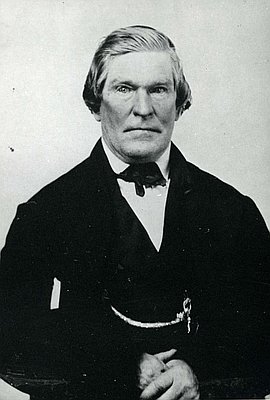Philip Foster facts for kids
Quick facts for kids
Philip Foster
|
|
|---|---|
 |
|
| Treasurer for the Provisional Government of Oregon | |
| In office 1844–1845 |
|
| Preceded by | William H. Willson |
| Succeeded by | Francis Ermatinger |
| Constituency | Oregon Country |
| Personal details | |
| Born | January 29, 1805 Argyle, Maine, U.S. |
| Died | March 17, 1884 (aged 79) Eagle Creek, Oregon, U.S. |
| Spouse | Mary Charlotte |
| Relations | Francis Pettygrove |
| Children | Lucy Foster, Egbert Foster |
| Residences | Eagle Creek, Oregon |
Philip Foster (born January 29, 1805 – died March 17, 1884) was an important early settler in what is now Oregon, United States. In 1847, he created a farm in Eagle Creek. This farm became a very important stopping place for pioneers traveling west on the famous Oregon Trail. About 10,000 people are thought to have stopped there. Today, his farm is recognized as a historic place.
Contents
Philip Foster's Early Life
Philip Foster was a successful businessman from Argyle, Maine. In the early 1800s, like many others, he decided to move west. He saw many chances for new businesses in the Oregon Country.
In 1842, Philip Foster and his family sailed from New York to Oregon. They traveled on a ship called the Victoria. His wife, Mary Charlotte, was the sister of Francis William Pettygrove, whose family also came along. They stopped in the Sandwich Islands (now Hawaii) for six months. Finally, in 1843, they arrived in the Willamette Valley at Oregon City.
Life in Oregon
Once in Oregon City, Philip Foster and Francis Pettygrove opened a general store. This two-story building was both their store and the Foster family's home. Philip Foster also started other businesses, including a flour mill with Dr. John McLoughlin. In 1844, Philip Foster became the second treasurer for the Provisional Government of Oregon. This was an early government in the Oregon Country before it became a U.S. territory.
Building the Barlow Road
In 1845, a pioneer named Sam Barlow was leading a wagon train. He did not want to pay to float down the dangerous Columbia River. So, he and his group looked for a new route around Mount Hood. Other wagon trains joined them. Barlow, Joel Palmer, and another traveler named Lock searched for a path around the mountain.
Barlow and a fellow traveler, William H. Rector, tried to create a trail. But they got lost on the mountain. Local Native Americans and cattle drovers helped rescue them. Barlow then met Philip Foster at his store in Oregon City. Barlow bought supplies and rented oxen to help his group, who were stuck in the snow.
Philip Foster then became Sam Barlow's business partner. Together, they built the Mount Hood Toll Road in 1846. This road is now known as the Barlow Road. It became the very last part of the overland Oregon Trail that led to Oregon City.
Foster's Place: A Rest Stop for Pioneers
Philip Foster moved his family from Oregon City and settled along the new toll road. Here, he created a busy rest stop. He had a store, cabins for rent, orchards, gardens, and pastures for animals to graze. This place became known as "Foster's Place" or "Foster's Ranch."
Thousands of wagons and guests stopped at the Fosters' home. Sometimes, the place was very crowded. Some travelers paid to sleep on the family's parlor floor. The Foster family also cooked meals for the pioneers. By charging for their services, the Fosters became very successful. Philip Foster also offered other services, like blacksmith repairs and a special cabin for overnight guests.
Philip Foster died on March 17, 1884, from a heart attack at his home in Eagle Creek. His wife, Mary-Charlotte, had passed away earlier in 1880 from typhoid fever. The Philip Foster Farm has been saved and is now open for visitors to learn about pioneer life. It is listed on the National Register of Historic Places.

